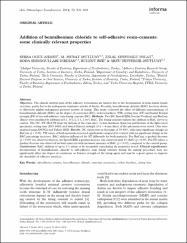| dc.contributor.author | Oğuz Ahmet, Serra | |
| dc.contributor.author | Mutluay, Mustafa Murat | |
| dc.contributor.author | Seyfioǧlu Polat, Zelal | |
| dc.contributor.author | Seseoğulları-Dirihan, Roda | |
| dc.contributor.author | Bek, Bülent | |
| dc.contributor.author | Tezvergil-Mutluay, Arzu | |
| dc.date.accessioned | 10.07.201910:49:13 | |
| dc.date.accessioned | 2019-07-10T19:36:23Z | |
| dc.date.available | 10.07.201910:49:14 | |
| dc.date.available | 2019-07-10T19:36:23Z | |
| dc.date.issued | 2014 | |
| dc.identifier.citation | Oğuz Ahmet, S., Mutluay, M. M., Seyfioğlu, Plat, Z., Seseoğulları Dirihan, R., Bek, B. ve Tezvergil Mutluay, A. (2014). Addition of benzalkonium chloride to self-adhesive resin-cements: Some clinically relevant properties. Acta Odontologica Scandinavica, 72(8), 831-838. https://dx.doi.org/10.3109/00016357.2014.913307 | en_US |
| dc.identifier.issn | 1502-3850 | |
| dc.identifier.uri | https://dx.doi.org/10.3109/00016357.2014.913307 | |
| dc.identifier.uri | https://hdl.handle.net/20.500.12511/1148 | |
| dc.description.abstract | OBJECTIVE: The clinical survival rates of the adhesive restorations are limited due to the deterioration of resin-dentin bonds over time, partly due to the endogenous enzymatic activity of dentin. Recently, benzalkonium chloride (BAC) has been shown to effectively inhibit endogenous protease activity of dentin. This study evaluated the effect of different concentrations of benzalkonium chloride (BAC) on the degree of conversion (DC), vickers hardness (VH), setting time (ST) and biaxial flexural strength (FS) of two self-adhesive resin luting cements (RC).METHODS: Two RC SpeedCEM (Ivoclar-Vivadent) and BisCem (Bisco) were modified by addition of 0.1, 0.5, 1, 1.5, 2 wt% BAC. The luting cements without the addition of BAC served as control. The DC (FT-IR/ATR from the bottom of the resin disc), vickers hardness (from top and bottom of the light-cured specimen), setting time (ISO 4049) and biaxial flexural strength (0.6 × 6 mm discs) of the specimens were tested. Data were analyzed using ANOVA and Tukeys HSD.RESULTS: DC results were in the range of 70-80%, with some significant changes in BisCem (p < 0.05). VH values of both materials increased significantly compared to control, with no significant change as the BAC percentage increases. BAC addition influenced the ST differently for both materials. For BisCem, a gradual decrease (p < 0.05) was observed whereas, for SpeedCEM, a gradual increase was observed until 1% BAC (p < 0.05). For FS values, a gradual decrease was observed for both materials with increased amounts of BAC (p < 0.05), compared to the control group.CONCLUSIONS: BAC addition of up to 1% seems to be acceptable considering the properties tested. Clinical significance. Incorporation of benzalkonium chloride to self-adhesive resin luting cements during the mixing procedure does not significantly affect the degree of conversion or flexural strength of the luting agent and may be a good option to improve the durability of adhesive interface. | en_US |
| dc.language.iso | eng | en_US |
| dc.publisher | Informa Healthcare | en_US |
| dc.rights | info:eu-repo/semantics/openAccess | en_US |
| dc.subject | Benzalkonium Chloride | en_US |
| dc.subject | Monomer Conversion | en_US |
| dc.subject | Self-Adhesive Cements | en_US |
| dc.subject | Setting Time | en_US |
| dc.subject | Vickers Hardness | en_US |
| dc.title | Addition of benzalkonium chloride to self-adhesive resin-cements: Some clinically relevant properties | en_US |
| dc.type | article | en_US |
| dc.relation.ispartof | Acta Odontologica Scandinavica | en_US |
| dc.department | İstanbul Medipol Üniversitesi, Diş Hekimliği Fakültesi, Protetik Diş Tedavisi Ana Bilim Dalı | en_US |
| dc.authorid | 0000-0002-1387-2989 | en_US |
| dc.identifier.volume | 72 | en_US |
| dc.identifier.issue | 8 | en_US |
| dc.identifier.startpage | 831 | en_US |
| dc.identifier.endpage | 838 | en_US |
| dc.relation.publicationcategory | Makale - Uluslararası Hakemli Dergi - Kurum Öğretim Elemanı | en_US |
| dc.identifier.doi | 10.3109/00016357.2014.913307 | en_US |
| dc.identifier.wosquality | Q3 | en_US |
| dc.identifier.scopusquality | Q2 | en_US |


















